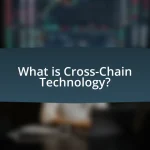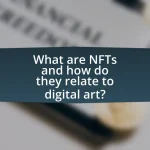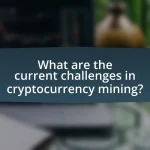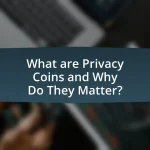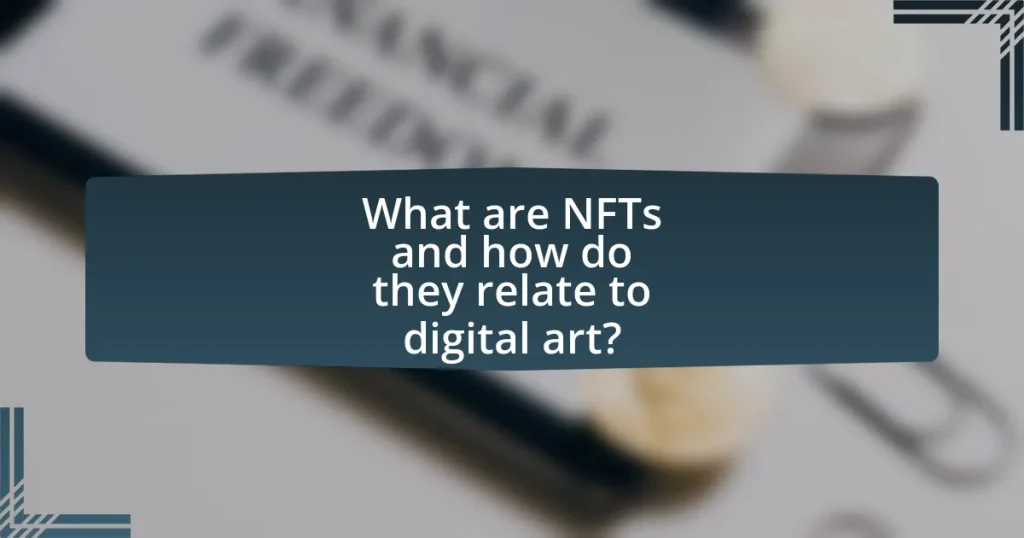NFTs, or Non-Fungible Tokens, are unique digital assets that utilize blockchain technology to verify authenticity and ownership, significantly impacting the digital art market. This article explores how NFTs function within the digital art ecosystem, detailing their role in ensuring ownership and provenance, the technologies that support their creation and sale, and the unique features they offer to artists, such as royalties on secondary sales. Additionally, it addresses the challenges artists face in the NFT space, the implications for copyright and intellectual property rights, and the environmental concerns associated with blockchain technology. The article also examines future trends in NFTs, including the integration of augmented and virtual reality, and provides best practices for artists looking to navigate this evolving landscape.

What are NFTs and how do they relate to digital art?
NFTs, or Non-Fungible Tokens, are unique digital assets verified using blockchain technology, which ensures their authenticity and ownership. In the context of digital art, NFTs allow artists to tokenize their work, creating a verifiable proof of ownership and provenance that can be bought, sold, or traded on various online platforms. This innovation has transformed the digital art market by enabling artists to monetize their creations directly, bypassing traditional galleries and intermediaries. The rise of NFTs has led to significant sales, such as Beeple’s “Everydays: The First 5000 Days,” which sold for $69 million at Christie’s in March 2021, highlighting the growing acceptance and value of digital art in the NFT space.
How do NFTs function in the digital art ecosystem?
NFTs function in the digital art ecosystem by providing a unique, verifiable ownership record for digital artworks on a blockchain. This technology allows artists to tokenize their work, creating a digital certificate of authenticity that can be bought, sold, or traded. The blockchain ensures that each NFT is distinct and cannot be duplicated, which addresses the issue of digital art’s reproducibility. According to a report by NonFungible.com, the NFT market reached a valuation of over $10 billion in 2021, highlighting the growing significance of NFTs in facilitating transactions and establishing provenance in the digital art space.
What technologies underpin the creation and sale of NFTs?
The technologies that underpin the creation and sale of NFTs include blockchain, smart contracts, and decentralized storage solutions. Blockchain technology provides a secure and transparent ledger for recording ownership and transaction history of NFTs, ensuring authenticity and provenance. Smart contracts, which are self-executing contracts with the terms of the agreement directly written into code, facilitate the automatic execution of transactions and enforce the rules governing the NFT. Decentralized storage solutions, such as IPFS (InterPlanetary File System), enable the storage of digital assets in a distributed manner, ensuring that the content associated with NFTs remains accessible and tamper-proof. These technologies collectively enable the unique characteristics and functionalities that define NFTs in the digital art space.
How do smart contracts facilitate NFT transactions?
Smart contracts facilitate NFT transactions by automating the execution of agreements between buyers and sellers on blockchain platforms. These self-executing contracts contain the terms of the transaction directly written into code, ensuring that once conditions are met, the transfer of ownership occurs without the need for intermediaries. For example, when a buyer purchases an NFT, the smart contract verifies the payment and automatically transfers the NFT to the buyer’s wallet, while simultaneously sending the payment to the seller. This process enhances security and transparency, as all transaction details are recorded on the blockchain, making them immutable and publicly accessible.
What unique features do NFTs offer to digital artists?
NFTs offer digital artists unique features such as verifiable ownership, scarcity, and the ability to earn royalties on secondary sales. These features empower artists by ensuring that their work is authenticated on the blockchain, which prevents unauthorized reproductions and establishes a clear provenance. Additionally, the scarcity of NFTs creates a market for limited editions, enhancing the perceived value of the artwork. Furthermore, smart contracts enable artists to receive a percentage of sales whenever their work is resold, providing ongoing revenue streams. This combination of ownership verification, scarcity, and royalty mechanisms distinguishes NFTs from traditional digital art distribution methods.
How do NFTs ensure ownership and provenance of digital art?
NFTs ensure ownership and provenance of digital art through blockchain technology, which provides a secure and immutable ledger for recording transactions. Each NFT is uniquely identified and linked to a specific digital asset, allowing for clear attribution of ownership. The blockchain records every transaction involving the NFT, creating a transparent history that verifies the authenticity and origin of the digital art. This traceability is crucial, as it prevents forgery and ensures that buyers can trust the legitimacy of their purchase.
What role do royalties play in NFT sales for artists?
Royalties in NFT sales provide artists with a continuous revenue stream from secondary sales of their work. This mechanism allows artists to earn a percentage of the sale price each time their NFT is resold, typically set at a rate between 5% to 10%. This is significant because traditional art sales often do not provide artists with any financial benefit from future sales, whereas NFTs leverage blockchain technology to enforce these royalty agreements automatically. The implementation of smart contracts ensures that artists receive their royalties without the need for intermediaries, thus enhancing their financial sustainability in the digital art market.
Why are NFTs considered revolutionary for the art market?
NFTs are considered revolutionary for the art market because they provide a unique way to verify ownership and provenance of digital artworks. This technology utilizes blockchain to create a secure, immutable record of ownership, which addresses the longstanding issue of authenticity in digital art. For instance, the sale of Beeple’s “Everydays: The First 5000 Days” for $69 million in 2021 exemplifies how NFTs can transform the valuation and sale of digital art, enabling artists to monetize their work directly without intermediaries. This shift empowers creators, enhances market accessibility, and fosters a new economic model within the art world.
How do NFTs democratize access to art ownership?
NFTs democratize access to art ownership by enabling fractional ownership and lowering entry barriers for collectors. Through blockchain technology, NFTs allow multiple individuals to own a share of a digital artwork, making it financially accessible to a broader audience. For instance, platforms like Nifty Gateway and Rally facilitate the purchase of fractionalized NFTs, allowing users to invest in high-value art pieces that would otherwise be out of reach. This shift not only expands the market for artists but also fosters a diverse community of collectors, enhancing the overall accessibility of art ownership.
What impact do NFTs have on traditional art valuation?
NFTs significantly influence traditional art valuation by introducing new market dynamics and altering perceptions of ownership and authenticity. The rise of NFTs has created a digital marketplace where artists can sell their work directly to collectors, often at higher prices than traditional galleries would offer. This shift has led to increased competition and a reevaluation of what constitutes value in art, as digital assets can now command prices comparable to physical artworks. For instance, a digital artwork by Beeple sold for $69 million at a Christie’s auction in 2021, highlighting how NFTs can elevate the perceived worth of digital art and challenge traditional valuation methods. Consequently, traditional art markets are adapting to these changes, as artists and collectors alike navigate the intersection of physical and digital art.
How are NFTs changing the way art is created and consumed?
NFTs are transforming the creation and consumption of art by enabling digital ownership and provenance verification. Artists can mint their works as NFTs, ensuring that each piece is unique and traceable on the blockchain, which enhances the value of digital art. This shift allows creators to receive royalties from secondary sales, as smart contracts can be embedded in the NFTs, ensuring they benefit from future transactions. Additionally, NFTs democratize access to art, allowing collectors to purchase works directly from artists without intermediaries, thus fostering a more direct relationship between creators and consumers. The rise of platforms like OpenSea and Rarible has facilitated this change, providing artists with new avenues to showcase and sell their work globally.
What challenges do artists face when using NFTs?
Artists face several challenges when using NFTs, including high transaction fees, market volatility, and environmental concerns. High transaction fees on platforms like Ethereum can significantly reduce artists’ profits, making it financially burdensome to mint and sell NFTs. Market volatility poses a risk as the value of NFTs can fluctuate dramatically, leading to uncertainty in income. Additionally, the environmental impact of blockchain technology, particularly energy-intensive proof-of-work systems, raises ethical concerns for artists who are environmentally conscious. These challenges can hinder artists’ ability to effectively engage with the NFT market and maximize their creative and financial potential.

What are the implications of NFTs on digital art ownership?
NFTs fundamentally alter digital art ownership by providing verifiable proof of authenticity and provenance. This technology enables artists to tokenize their work, ensuring that each piece is unique and can be owned, bought, and sold in a decentralized manner. The blockchain records every transaction, which enhances transparency and trust in ownership claims. For instance, a study by the University of Cambridge highlights that NFTs can increase the value of digital art by creating scarcity, as artists can limit the number of tokens associated with their work. This shift empowers artists with new revenue streams and control over their creations, while collectors gain a secure method to invest in and showcase digital art.
How do NFTs alter the concept of ownership in the digital realm?
NFTs redefine ownership in the digital realm by providing verifiable proof of authenticity and uniqueness for digital assets. Unlike traditional digital files that can be easily copied, NFTs utilize blockchain technology to create a permanent, immutable record of ownership, ensuring that each token is distinct and traceable to its original creator. This transformation allows artists and creators to retain control over their work, as ownership can be transferred through sales while maintaining a clear history of provenance. The rise of NFTs has led to a new economic model for digital art, where scarcity and ownership are established in a previously limitless digital landscape.
What are the legal considerations surrounding NFT ownership?
Legal considerations surrounding NFT ownership include intellectual property rights, copyright issues, and the enforceability of contracts. NFT owners do not automatically gain copyright over the digital asset; they typically acquire a token that signifies ownership but not the underlying rights to the artwork. For instance, if an artist creates a digital piece and sells it as an NFT, the artist retains copyright unless explicitly transferred. Additionally, the terms of service of the NFT platform can dictate ownership rights and responsibilities, which may vary significantly. Legal disputes can arise if the ownership rights are not clearly defined, leading to potential litigation over unauthorized use or reproduction of the digital asset.
How do NFTs affect copyright and intellectual property rights?
NFTs primarily affect copyright and intellectual property rights by introducing a new layer of ownership and provenance for digital assets. They allow creators to tokenize their work, providing a verifiable proof of ownership that can be transferred or sold, which can complicate traditional copyright frameworks. For instance, while an NFT can signify ownership of a digital artwork, it does not automatically grant the buyer copyright or reproduction rights unless explicitly stated in the terms of the sale. This distinction is crucial, as it means that the original creator retains certain rights unless they are transferred. Legal cases, such as the lawsuit involving the artist Beeple, highlight the ongoing challenges and ambiguities in how NFTs interact with existing intellectual property laws, emphasizing the need for clearer regulations in this evolving landscape.
What are the environmental concerns associated with NFTs?
The environmental concerns associated with NFTs primarily stem from their reliance on blockchain technology, particularly proof-of-work systems, which consume significant amounts of energy. For instance, the Ethereum blockchain, which hosts a large number of NFTs, has been reported to use as much energy annually as some small countries, with estimates suggesting it consumes around 45 terawatt-hours per year. This high energy consumption contributes to increased carbon emissions, raising concerns about the ecological impact of minting and trading NFTs. Additionally, the electronic waste generated from the hardware used in mining operations further exacerbates environmental issues, highlighting the need for more sustainable practices in the NFT space.
How does blockchain technology impact energy consumption?
Blockchain technology significantly impacts energy consumption primarily through the energy-intensive processes associated with proof-of-work consensus mechanisms. These mechanisms, used by major cryptocurrencies like Bitcoin, require substantial computational power, leading to high electricity usage; for instance, Bitcoin mining alone consumes approximately 100 terawatt-hours annually, comparable to the energy consumption of entire countries. In contrast, alternative consensus mechanisms, such as proof-of-stake, are being adopted to reduce energy consumption, as they require far less computational power and thus lower electricity usage. This shift is crucial for enhancing the sustainability of blockchain applications, including NFTs in digital art, where energy-efficient solutions are increasingly prioritized.
What initiatives are being taken to mitigate the environmental impact of NFTs?
Initiatives to mitigate the environmental impact of NFTs include the transition to more energy-efficient blockchain technologies and the adoption of carbon offsetting strategies. Many NFT platforms are now utilizing proof-of-stake (PoS) consensus mechanisms, which significantly reduce energy consumption compared to traditional proof-of-work (PoW) systems. For instance, Ethereum, the leading blockchain for NFTs, is moving towards PoS with its Ethereum 2.0 upgrade, which is expected to decrease energy usage by approximately 99.95%. Additionally, some NFT creators and platforms are committing to carbon offset programs, investing in renewable energy projects, and supporting reforestation efforts to counterbalance their carbon footprints.

What future trends can we expect for NFTs in digital art?
Future trends for NFTs in digital art include increased integration with augmented reality (AR) and virtual reality (VR), enhanced interactivity, and the rise of fractional ownership. As digital art continues to evolve, artists and platforms are likely to leverage AR and VR technologies to create immersive experiences, allowing collectors to interact with art in new ways. Additionally, fractional ownership will enable more people to invest in high-value digital art pieces, democratizing access to the market. According to a report by NonFungible.com, the NFT market has seen exponential growth, with sales reaching over $10 billion in 2021, indicating a strong demand for innovative applications in digital art.
How might technological advancements shape the future of NFTs?
Technological advancements will significantly shape the future of NFTs by enhancing their functionality, accessibility, and integration into various digital ecosystems. Innovations such as improved blockchain scalability, interoperability between different platforms, and advancements in smart contract capabilities will enable NFTs to support more complex use cases, such as fractional ownership and dynamic content. For instance, Ethereum’s transition to a proof-of-stake model aims to increase transaction speed and reduce energy consumption, making NFT transactions more efficient. Additionally, the rise of Layer 2 solutions, like Polygon, allows for lower fees and faster processing times, which can attract a broader audience to the NFT market. These developments indicate that NFTs will evolve beyond mere collectibles, becoming integral to digital identity, virtual real estate, and interactive experiences in the metaverse.
What role will augmented reality and virtual reality play in NFT art?
Augmented reality (AR) and virtual reality (VR) will significantly enhance the experience and value of NFT art by providing immersive environments for viewing and interacting with digital artworks. AR allows users to overlay digital art onto the physical world, enabling a unique blend of reality and creativity, while VR creates fully immersive spaces where users can explore and engage with NFT art in a 3D environment. This integration not only increases the accessibility of digital art but also fosters community engagement and interaction among collectors and artists, as seen in platforms like Decentraland and Cryptovoxels, where users can showcase and trade their NFT art in virtual galleries.
How could AI-generated art influence the NFT landscape?
AI-generated art could significantly influence the NFT landscape by increasing the volume and diversity of digital artworks available for minting and trading. This technology allows artists to create unique pieces rapidly, which can lead to a surge in NFT offerings and attract a broader audience. For instance, platforms like Artbreeder and DeepArt utilize AI algorithms to generate art, demonstrating the potential for mass production of unique digital assets. As a result, the NFT market could see a shift towards more accessible and varied art forms, appealing to collectors and investors looking for innovative and novel pieces. Additionally, the integration of AI in art creation can challenge traditional notions of authorship and originality, prompting discussions about the value and ownership of digital art in the NFT space.
What best practices should artists follow when creating NFTs?
Artists should follow best practices such as ensuring originality, selecting the right platform, and engaging with their audience when creating NFTs. Originality is crucial because unique creations are more likely to attract buyers and maintain value in the competitive NFT market. Choosing the right platform, such as OpenSea or Rarible, is important as different platforms offer varying fees, audience reach, and features that can impact the success of the NFT. Engaging with the audience through social media and community forums helps build a loyal following and increases visibility, which is essential for selling NFTs effectively.
How can artists effectively market their NFTs to reach a wider audience?
Artists can effectively market their NFTs to reach a wider audience by leveraging social media platforms, engaging with online communities, and collaborating with influencers. Social media platforms like Twitter and Instagram allow artists to showcase their work, share behind-the-scenes content, and connect with potential buyers. Engaging with online communities, such as NFT marketplaces and forums, helps artists build relationships and gain visibility among collectors. Collaborating with influencers in the NFT space can amplify an artist’s reach, as these influencers often have established audiences interested in digital art. According to a report by NonFungible.com, the NFT market saw a significant increase in sales, indicating that effective marketing strategies can lead to greater audience engagement and sales.
What platforms are recommended for launching NFT art projects?
Recommended platforms for launching NFT art projects include OpenSea, Rarible, and Foundation. OpenSea is the largest NFT marketplace, allowing artists to mint, buy, and sell NFTs with a wide audience. Rarible offers a decentralized platform where creators can issue their own tokens and earn royalties on secondary sales. Foundation focuses on community-driven curation, enabling artists to showcase their work and connect with collectors. These platforms are widely recognized in the NFT space, providing essential tools and visibility for artists to successfully launch their projects.
